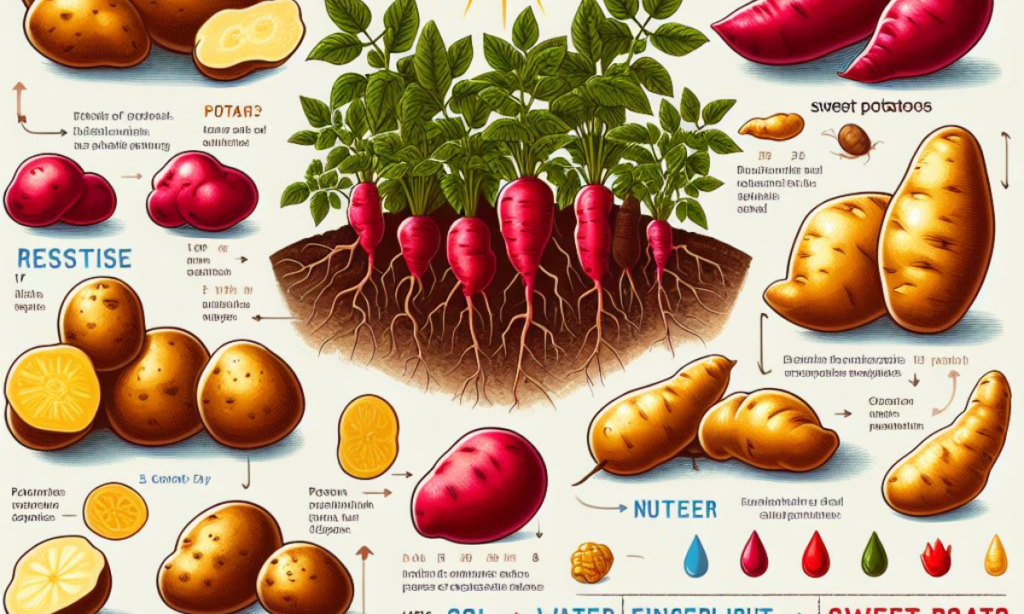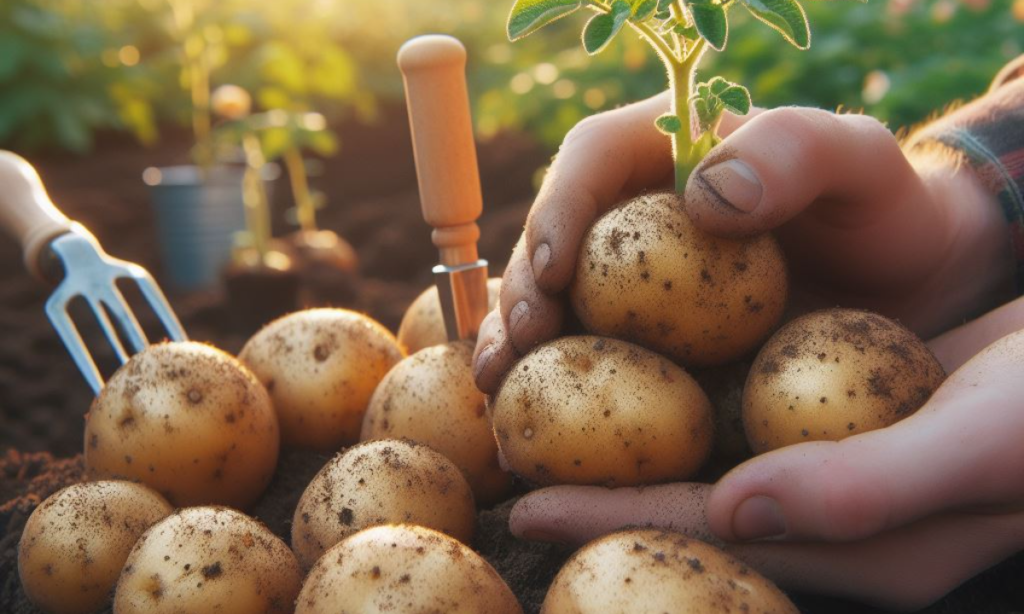Timing is critical in terms of planting potatoes, and finding the perfect time to sow is essential. The best time to plant them relies upon elements consisting of place, climate, and potato range. As desired, it’s far endorsed to plant potatoes in early spring, after the soil has warmed up and the chance of frost has surpassed. Planting too early can bring about a slow increase and the ability to rot, at the same time as planting too past due may additionally moreover shorten the developing duration. Consider the specific requirements of your selected potato variety and the purpose of a planting window that allows for 80 to 100 days of boom earlier than frost arrives. By considering these factors, including “Potato Planting Primer Finding the Perfect Time to Sow,” you can maximize your probability of a successful potato harvest.
Recommended: Low Maintenance Garden Ideas
Factors Affecting Potato Planting Time
Several elements impact the optimum time for planting potatoes. Climate conditions, which include common temperatures and frost dates, play a huge position. Soil temperature is vital, with potatoes thriving in temperatures between 45 and 50 ranges Fahrenheit. The potato range selected also topics, as special sorts have varying temperatures and growing condition requirements. The period of the developing season has to be considered to permit sufficient time for maturation earlier than frost. Moisture degrees, seed availability, pest and disease stress, crop rotation practices, and private alternatives also affect the planting time decision. Considering those elements will assist make certain a a hit potato crop.
Determining the Optimal Planting Window

To attain satisfactory outcomes when planting potatoes, recall numerous key factors. Prepare the soil thoroughly, ensuring it’s far nicely loosened and freed from weeds. Plant after the closing anticipated frost to avoid cold harm. Aim for moist but now not waterlogged soil. Take into account the daylight temperatures, with the optimum range being 60 to 70 degrees Fahrenheit. Use brilliant seed potatoes. Practice crop rotation to save your pests and sicknesses. Consult range-unique pointers and take into account your preferred harvest timing. Pay interest to microclimate factors and draw on private revel in and experimentation to decide the correct planting window in your region.
Considerations Based on Location and Climate
When figuring out the most fulfilling planting time for potatoes, it’s far important to not forget the specific vicinity and weather conditions. Different regions have varying climates, which at once impact the success and increase of potato flora. By thinking about the subsequent elements, you could make informed selections about while to plant potatoes in your specific vicinity
Hardiness Zone
Identify the hardiness sector of your location. Hardiness zones are determined based on average minimal iciness temperatures and provide a standard guiding principle for plant suitability. This information enables you to decide on potato types that are well-adapted to your climate.
Temperature Extremes
Evaluate the temperature extremes in your region. Consider the common temperatures in the course of the growing season as well as the probability of heatwaves or severe bloodless spells. Potatoes thrive in temperate climates, so expertise in the temperature variety of your area permits you to gauge the suitability of potato cultivation.
Frost Dates
Determine the common dates of the number one and closing frost to your area. Planting potatoes too early, earlier than the danger of frost has passed, can result in damage or stunted boom. Conversely, planting too overdue can also restrict the development period. By aligning your planting agenda with frost dates, you may decrease the threat of frost damage and maximize the growing season.
Rainfall Patterns
Consider the rainfall patterns in your vicinity. Potatoes require consistent moisture, but, excessive rainfall can cause waterlogged soil and rotting tubers. Conversely, prolonged dry spells can encourage pressure and prevent boom. Understanding the precipitation styles in your area assists you in planning irrigation techniques and making sure your potatoes attain the proper quantity of water.
Sunlight Exposure
Evaluate the amount of daylight your planting vicinity gets. Potatoes generally require a minimum of six hours of direct sunlight according to day for the greatest increase. Assess the orientation of your lawn or area to decide the sunniest spots in which potatoes can thrive
Microclimates
Identify any microclimates within your developing vicinity. Microclimates are localized areas with particular temperature, moisture, or wind conditions. Factors which include buildings, trees, or slopes can create variations in temperature and publicity. Understanding microclimates can help you strategically area your potato vegetation for the most effective boom.
Understanding Potato Variety Requirements

To grow potatoes efficaciously, it’s far essential to recognize the specific necessities of various potato sorts. Consider the increased habits of the types, including determinate or indeterminate, to devise spacing and assist structures hence. Additionally, choose sorts which can be resistant or tolerant to common potato illnesses familiar to your place to decrease crop loss and decrease the want for chemical treatments. Take into consideration the adulthood time of the types, starting from early to past due, to align with your preferred harvest time and the duration of your developing season. Consider tuber characteristics, which include length, form, pores and skin colouration, and flesh shade, to make sure they meet your culinary options and intended use. Furthermore, check the storage features of the types if you plan to keep potatoes for an extended length. Lastly, select types which can be nicely tailored to the climate situations of your vicinity to decorate fulfilment and productiveness in your potato cultivation efforts.
The Importance of Soil Temperature
Soil temperature plays an important position in the success boom and improvement of potatoes. Understanding the importance of soil temperature and its effect on potato cultivation permits you to make knowledgeable decisions for the most beneficial planting and crop management.
Germination and Root Development
Soil temperature immediately impacts the germination gadget and the next root development of potato plant life. For right germination, soil temperatures need to be within the range of 45 to 50 levels Fahrenheit (7 to 10 levels Celsius). If the soil is simply too bloodless, germination can be behind schedule or choppy, main to a horrific repute quo and functionality yield loss.
Tuber Formation
As potato plant life matures, soil temperature continues to influence tuber formation. Warmer soil temperatures promote higher tuber increase and development. However, excessively excessive temperatures can negatively impact tuber pleasant and yield. Aim for soil temperatures between 60 and 70 stages Fahrenheit (15 to 21 tiers Celsius) at some stage in the tuber formation level.
Nutrient Uptake and Plant Health
Soil temperature impacts nutrient availability and uptake via potato flora. Optimal soil temperatures enhance the pastime of soil microorganisms, selling nutrient release and making them greater on hand to plant roots. This leads to progressed nutrient uptake, healthier plant life, and better general growth.
Disease and Pest Management
Soil temperature additionally performs a position in disorder and pest control. Certain soilborne pathogens and pests have specific temperature choices for optimum increase and hobby. By monitoring and coping with soil temperature, you could doubtlessly reduce the prevalence of soilborne sicknesses and pests that could damage potato plant life.
Monitoring Soil Temperature
To determine the soil temperature, use a soil thermometer to determine the temperature at the favoured planting depth. Take more than one reading across your planting region to account for any temperature variations. Regular monitoring of soil temperature helps you to make informed selections at the same time as planting potatoes and installing pressure-suitable cultural practices.
Soil Moisture and Temperature
Soil moisture tiers can impact soil temperature, as water has a better specific heat ability than dry soil. Adequate soil moisture can help alter soil temperature and hold the most appropriate situations for potato increase. However, make sure proper drainage to save you from waterlogging, which can cause root rot and other troubles.
Maximizing Success with Timely Potato Planting
Timely planting is essential for reaching achievement in potato cultivation. Several key elements can assist maximize your chances of a fruitful harvest. Firstly, recall the soil temperature. Wait till the soil temperature reaches not less than forty-five to 50 stages Fahrenheit (7 to ten ranges Celsius) for surest germination. It is likewise vital to plant after the remaining spring frost to keep away from capability harm from cold temperatures. Additionally, ensure the soil is well-drained and wet but now not waterlogged to offer perfect developing surroundings for the potatoes. Monitoring daylight temperatures is crucial, as potatoes thrive in moderate temperatures starting from 60 to 70 stages Fahrenheit (15 to 21 stages Celsius). Select super seed potatoes that are certified disease-loose and suitable for your location. Practising crop rotation helps save you from the buildup of pests and illnesses, ensuring a healthier plant life. Finally, draw from your private revel and experiment with planting dates to find the optimum window on your particular conditions. By considering those factors, you could maximize success with well-timed potato planting and growth the chance of a successful harvest.
Conclusion

Several factors ought to be taken into consideration, together with soil temperature, frost dates, soil moisture, and seed fine. Waiting until the soil temperature reaches around forty-five to 50 stages Fahrenheit (7 to 10 tiers Celsius) ensures the most beneficial germination and boom. Planting after the remaining spring frost minimizes the threat of cold damage to younger vegetation. It is important to pick properly-tired soil that is wet but no longer waterlogged to create a positive growing environment. Selecting excellent seed potatoes which can be certified sickness-loose contributes to overall crop health. Crop rotation helps prevent the accumulation of pests and illnesses. Personal revel in and experimentation with planting dates can in addition refine the timing based totally on local situations. By carefully thinking about those elements, growers can make knowledgeable decisions on whether to plant potatoes and increase their probability of a successful and ample harvest.

